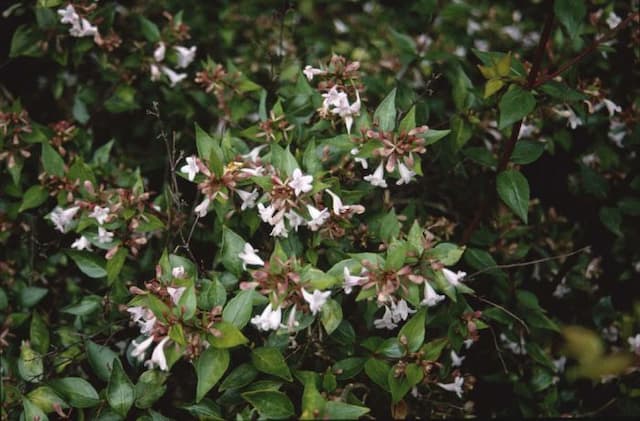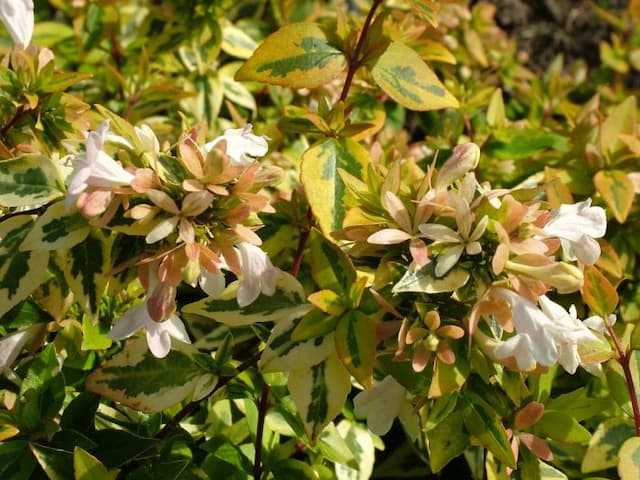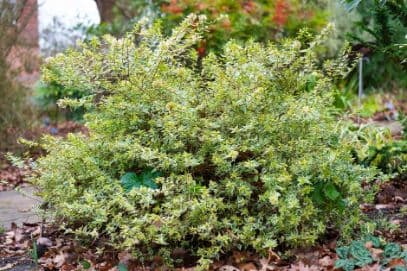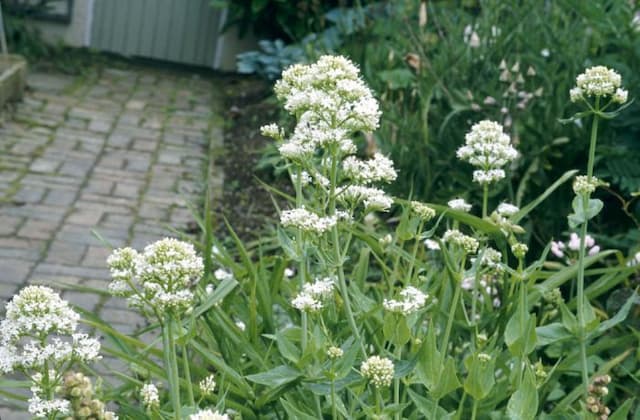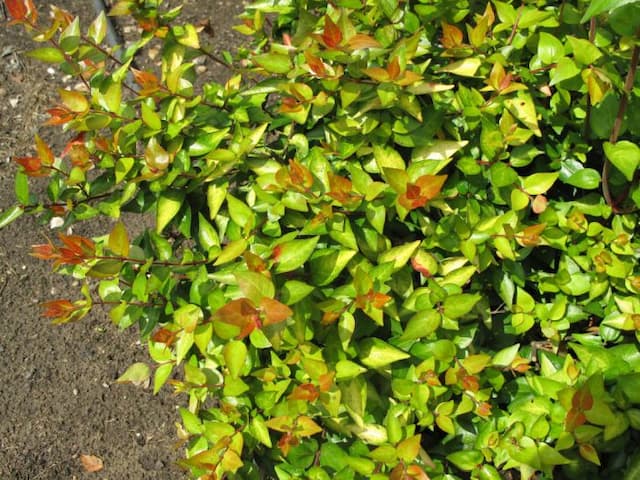Yunnan Dipelta Dipelta yunnanensis

ABOUT
The plant commonly known as Yunnan dipelta is an ornamental shrub with a unique appearance. Its most striking feature is the blooms it produces, which are large, funnel-shaped and typically white or pale pink with yellow throats. The flowers are fragrant and appear in clusters, drawing attention with their showy display. The leaves of Yunnan dipelta are lance-shaped and arranged oppositely on the stems, with a lush green color that provides a beautiful contrast to the delicate coloring of the flowers. Outside of its blooming season, the plant is recognized for its appealing foliage, which can be a standout in any garden setting. The stems are layered and may have a slightly arching form, giving the shrub a graceful look. With proper care, the plant showcases a balance of verdant leaves and enchanting flowers, making it a favorite among garden enthusiasts for adding aesthetic charm to outdoor spaces.
About this plant
 Names
NamesFamily
Caprifoliaceae
Synonyms
Yunnan Dipelta
Common names
Dipelta yunnanensis.
 Toxicity
ToxicityTo humans
Dipelta yunnanensis, more commonly known as Yunnan dipelta, does not have a well-documented profile regarding its toxicity to humans. Most sources do not indicate that it is significantly toxic to humans. However, in the absence of specific toxicological data, it is generally advisable to exercise caution and avoid ingesting any parts of plants that are not known to be edible. If any part of the plant is accidentally consumed and symptoms develop, it is important to seek medical attention.
To pets
Yunnan dipelta does not have widely known or reported toxic effects on pets. However, the lack of data on its toxicity means that caution should be used. Pet owners should prevent their animals from ingesting parts of this plant. If a pet does consume Yunnan dipelta and exhibits any unusual symptoms, consult a veterinarian as a precautionary measure.
 Characteristics
CharacteristicsLife cycle
Perennials
Foliage type
Deciduous
Color of leaves
Green
Flower color
Pink
Height
6-10 feet (1.8-3 meters)
Spread
6-10 feet (1.8-3 meters)
Plant type
Shrub
Hardiness zones
6
Native area
China
Benefits
 General Benefits
General Benefits- Ornamental value: Dipelta yunnanensis, commonly known as Yunnan dipelta, is appreciated for its showy flowers and overall aesthetic appeal in ornamental horticulture.
- Habitat support: Provides food in the form of nectar for various pollinating insects, thus supporting local biodiversity.
- Landscape diversity: Yunnan dipelta contributes to the diversity of landscapes by introducing unique foliage and floral characteristics, which can be particularly beneficial in garden design.
- Shade provider: Mature shrubs of Yunnan dipelta can offer shade in gardens and landscapes.
- Erosion control: The root systems of shrubs like Yunnan dipelta can help stabilize soil and control erosion on slopes or in areas prone to soil degradation.
 Medical Properties
Medical PropertiesThis plant is not used for medical purposes.
 Air-purifying Qualities
Air-purifying QualitiesThis plant is not specifically known for air purifying qualities.
 Other Uses
Other Uses- Dipelta yunnanensis, commonly known as Yunnan dipelta, can be used as a natural dye source for fabrics, providing subtle colors derived from its flowers and bark.
- The wood of Yunnan dipelta may be utilized in the crafting of small wooden objects, such as picture frames or trinket boxes, due to its fine grain.
- This plant's fibrous bark has potential for making natural ropes or cords, particularly in small-scale or traditional applications.
- As a subject for botanical studies and education, Yunnan dipelta offers an example of plant adaptation and evolution, considering its specific habitat requirements.
- In landscape design, the Yunnan dipelta serves as an ornamental plant, appreciated for its attractive flowers and foliage.
- The leaves of the plant can be used in composting as a source of green matter, contributing to a nutrient-rich compost.
- Yunnan dipelta's dense shrubbery makes it suitable for creating privacy screens or hedges in residential gardens.
- The distinctive branching pattern and shape of Yunnan dipelta make it a good candidate for bonsai cultivation.
- During seasonal transitions, the plant is used as a natural indicator of climate change, as the timing of its flowering can reflect environmental conditions.
- The fallen petals of the Yunnan dipelta offer a naturally biodegradable option for creating confetti for outdoor celebrations or events.
Interesting Facts
 Feng Shui
Feng ShuiThe Dipelta yunnanensis is not used in Feng Shui practice.
 Zodiac Sign Compitability
Zodiac Sign CompitabilityThe Dipelta yunnanensis is not used in astrology practice.
 Plant Symbolism
Plant Symbolism- Rarity: As Dipelta yunnanensis is not a widely known or common plant, it represents the uniqueness and precious nature in certain contexts, much like rare experiences or individuals in one's life.
- Beauty in Isolation: Since Dipelta yunnanensis originates from the Yunnan region in China and is not commonly found in everyday gardens, it can symbolize the concept of beauty existing in isolation, or the idea that precious things are often hidden or not immediately within reach.
- Adaptation: This plant has adapted to specific environmental conditions in China, making it a symbol of resilience and the ability to thrive in a particular niche.
 Water
WaterFor the Yunnan Bush, it is essential to water the plant deeply enough so that water reaches the roots, usually about 1-2 gallons every week during the growing season. Allow the top inch of the soil to dry out between waterings, but avoid letting the soil become completely dry. In hot, dry periods, you may need to water more frequently, while in cooler or rainy times, less watering is necessary. During winter, when the plant is dormant, reduce watering to every other week or when the soil is dry to the touch.
 Light
LightThe Yunnan Bush thrives in full sun to partial shade. It's best to find a spot where the plant can receive at least four to six hours of sunlight daily. However, too much intense afternoon sun in hot climates can cause leaf scorch, so in such environments, it benefits from light shade during the peak afternoon hours.
 Temperature
TemperatureThe Yunnan Bush does well in a range of temperatures - it can withstand a minimum temperature around 20°F and a maximum temperature of about 85°F. The ideal temperature range for this plant is between 60°F and 75°F. Ensure protection from extreme cold by providing mulch or shelter if temperatures dip below the minimum range.
 Pruning
PruningPrune the Yunnan Bush after it has finished flowering, usually in late winter or early spring, to maintain its shape and encourage new growth. Remove any dead or damaged branches, and cut back up to one-third of the older stems to promote bushier growth. Pruning too late in the season can remove flower buds and reduce bloom.
 Cleaning
CleaningAs needed
 Soil
SoilYunnan Bush Honeysuckle requires well-draining, fertile soil with a slightly acidic to neutral pH level, around 6.0 to 7.0. A mix composed of loamy soil, peat, and perlite or sand can ensure good drainage and aeration, which is crucial for the plant's root health.
 Repotting
RepottingYunnan Bush Honeysuckle should be repotted every 2-3 years or when it outgrows its current pot. This will provide space for root growth and replenish the soil's nutrients, which are essential for its overall health.
 Humidity & Misting
Humidity & MistingYunnan Bush Honeysuckle prefers moderate humidity levels, generally around 40% to 60%. It can tolerate lower humidity, but maintaining this range is beneficial for optimal growth and flowering.
 Suitable locations
Suitable locationsIndoor
Place in bright, indirect light with moderate humidity.
Outdoor
Plant in partial shade, protect from strong winds.
Hardiness zone
5-8 USDA
 Life cycle
Life cycleDipelta yunnanensis, commonly known as Yunnan dipelta, begins its life cycle as a seed that requires a period of stratification to break dormancy. Upon germination, which may occur in spring, the seedling develops a root system and shoots, gradually forming a hardy deciduous shrub that can withstand cold winters. In the juvenile stage, the plant focuses on vegetative growth, expanding its foliage and branching structure. As it reaches maturity, Yunnan dipelta produces fragrant, bell-shaped flowers in late spring or early summer, which are pollinated by insects, leading to the formation of seed capsules. Following pollination, the seeds mature and are eventually dispersed in late summer or autumn, starting the cycle anew if they find a suitable environment to grow. During its lifecycle, the shrub grows slowly, reaching full size and maturity over several years, and can live for many years if growing conditions are favorable.
 Propogation
PropogationPropogation time
Spring-Early Summer
Dipelta yunnanensis, commonly known as the Yunnan Dipelta, is best propagated through semi-hardwood cuttings. These cuttings should ideally be taken in the late summer, after the current season's growth has started to mature and harden slightly. To propagate, cut a 6 to 8-inch (15 to 20 cm) length of stem that includes several leaves and at least one node. Dip the cut end in rooting hormone to encourage root development and plant it in a well-draining potting mix. It's important to keep the soil consistently moist but not waterlogged and to place the cutting in a warm spot with indirect light. Roots should establish within a few weeks, after which the young plants can gradually be acclimatized to outdoor conditions before planting in their final location.
